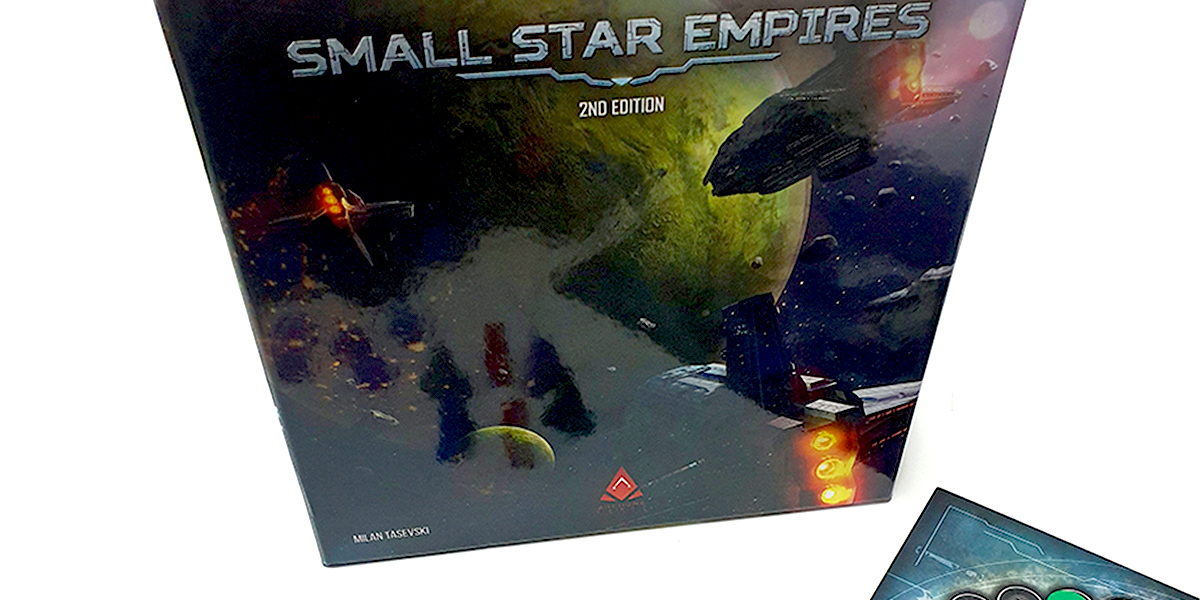Small Star Empires is a sci-fi board game that reminds me one sad thing: I live in the era in which is too late to explore the earth and too early to explore the space. This game is published by Archona Games. I met Milan during my visit to Spiel Essen 2018 (the report is here). What makes this game different in comparison to other outer space board games? Well, join our journey to dominate the space in this article.
What’s in the box?
Small Star Empire is a very compact board game. I am always in love with a board game packed so tight that fits easily in my shelf. The board is actually modular; it means you will always a different experience when you play. The tiles are hexagonal and they represent uncharted territories full of mysteries: nebula, other solar systems, and your home system. We also get some other special tiles that give variation to the game (black hole and wormhole).
You also get your ship, trade station, and the colony; these components were made of plastic. Small Star Empire would accommodate up to 4 players. You can, however, play it with 2 players as well.
Small Star Empires’ gameplay
The setup
As I mentioned earlier, the board is pretty much modular. There is a recommended setup for new players, too. This helps to teach them to grasp the basic of this game. Anyway, whatever your setup is, the home systems will always be placed on the edge of the board. Then, each player takes numbers of ships that depend on the player count; put these on your home tile.
The gameplay
The game is pretty simple, actually. In your turn, you have to do two mandatory steps: move one ship and take control of the system. You can move only to an unoccupied system except for wormhole and black hole system. While moving, you can also move through the system you control and through the wormhole. The ship can move as far as possible; when it’s damaged, it only moves 2 tiles at maximum. It can be repaired by going home to your home system.
When you move into an unoccupied system, you have to take control by placing a colony or a trade station. If you cannot move your ship, then you have to pass your turn. The game ends if there’s no legal move left or if all players have used all their colonies and trade stations.
Calculating points
When the end-game is triggered, calculate the points gained by each player. The points from the planet system depend on the number of planets on that system. You also get points based on the number of nebula system of the same colour you control; more nebula of the same colour you get, more points you can obtain. Trade station will contribute 1 point for each adjacent system controlled by other players, including the colonies and the trade stations. You also get bonus points if you control the biggest territory. Whoever gets the most points win the game. The tie-breakers prioritisation is unspent colonies, then unspent trade stations, and lastly, controlled planets.
Thoughts on the game
The gameplay and experience
Small Star Empires’ rule is really easy to understand. It was drafted perfectly and I do not have any trouble to understand it. You only need a very short time to read and understand it. Simply said, the rulebook is really clear and player-friendly. Anyway, I forgot to mention that this is pretty much an area control game.
The modular board offers some replayability; plus there are several variants to set up so the players may also play in order to get different experience and different gameplay strategy to win. The possibility to play with the wormholes and the black holes, for example, will really change how you should play in order to extract the most points in the end.
The gameplay is pretty straightforward: you move, you take control, and you score points based on the area you control. Your components (colonies and trade stations) are somewhat limited and it forces you to keep your movement as strategic as possible. For example, you will be interested in putting your colonies on the system with the most planets; or the nebulae with the colour you already have. The thing with the trade stations is quite different. You have to build it adjacent to as many as other players’ components to score as many points as possible. It’s actually a pretty nice touch the theme.
The movement is really constraining. With the setup for the default gameplay, players tend to confine other players’ movement because it’s not possible to go through someone else’s controlled system. This constraint is somewhat lifted up with the variants that will be explained later.
The game is for 2-4 players. I tried all player counts and I feel that 2-player-game was not that amazing. The game is quite enjoyable with 4 players, though! Because it’s easy to learn the rules (and easy to set up), Small Star Empires will attract new players easily, too.
The appearance and components
The artwork is pretty slick. Although there’s not much to see on the hexagonal tiles, I got the sci-fi feeling from the cover. It hits the spot The components for the colonies and trade stations are also neat and really solid. My version is the retail version with the wood components. It really gives the modern abstract game vibes to Small Star Empires.
The variants and the expansions
I have tried the game with the variants and the expansions. The normal setup will not really make you going anywhere because of the constraints of movements I mentioned above. With the wormhole, you can jump your ship out of the cage your opponent built. Not only that, but several variants also provide more strategic aspects to the gameplay. For example, with the asteroid field variant, you should be careful to drive the ship because it may damage the ship.
The expansions, Dawn of Discoveries and The Galactic Divide, make good combinations with the core game. The Galactic Divide gives an additional variable player power mechanic to the game. It’s neatly designed and I really like the added abilities we can trigger by paying the power as the cost. This power value can be gathered by your civilisation by building the battle station. This new component will also protect your system because it nullifies the opponents’ ability.
Meanwhile, the expansion Dawn of Discoveries adds two main components to the gameplay: technology deck and research centres. Your task is not only to expand your galactic civilisation but also to build research centres in order to get minerals to purchase (or discover) new technologies. The new tech will help your cause somehow. Anyway, this expansion adds the card drafting mechanic into your game.
Verdict
The core game of Small Star Empires is really interesting. It’s small, light, fast, and fun to play. The modular board offers high replayability if you play with other variants. The default gameplay is quite move-constraining and you will finish your game session in no time, so I would really recommend playing with the expansion or the variants included in the core box. This movement constraint is also the reason why the gameplay is pretty quick, although it still has a strategic aspect in every gameplay.
The expansions really complement the game well. With the expansion, Small Star Empires’ setup time is not significantly different. The game’s complexity is increasing but still at a reasonable level for casual players to enjoy it. My favourite is the expansion The Galactic Divide.
I would recommend Small Star Empires for casual players, though. It surely has depth but it’s not the depth you are looking for if you are a more experienced player. If you are bored throwing dice, then this would be a good option.
I’d say Milan and his team did a very good job with this game. They also developed a similar area control game with a different theme, Small Samurai Empires. I’m looking forward to it.
I am a full-time food technologist during weekdays. However, when the calendar hits weekends, I transform into an avid board gamer. I am a hardcore Legend of the Five Rings (L5R) LCG player from Fantasy Flight Games (FFG). Current hobby: buying board games. My shelf of shame’s list is getting longer, thanks to you, Kickstarter.










